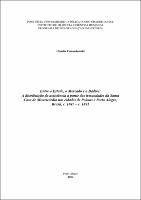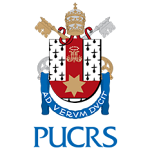| Share record |


|
Please use this identifier to cite or link to this item:
https://tede2.pucrs.br/tede2/handle/tede/2497| Document type: | Tese |
| Title: | Entre o Estado, o Mercado e a Dádiva : a distribuição da assistência a partir das irmandades da Santa Casa de Misericórdia nas cidades de Pelotas e Porto Alegre, Brasil, c. 1847 c. 1891 |
| Author: | Tomaschewski, Cláudia  |
| Advisor: | Heinz, Flavio Madureira |
| Abstract (native): | Esta tese analisa, em perspectiva comparada, as irmandades da Santa Casa de Misericórdia das cidades de Pelotas e Porto Alegre na província do Rio Grande do Sul, Brasil, entre cerca de 1847 e 1891. Estas irmandades eram fundadas pelos ricos locais para prestar assistência aos pobres, e foram instituições típicas do Império Português que diferentemente de outros Estados europeus centralizou os serviços em uma única instituição que recebeu privilégios e apoio real. A fundação das santas casas naquelas cidades é percebida dentro de um contexto maior de ocupação e formação do Império do Brasil, por isso são também inventariadas as irmandades da Misericórdia e hospitais fundados no território nacional. Na tese é realizada uma análise das irmandades propriamente ditas, onde procuro perceber suas formas de organização, composição social e burocratização dos serviços. O centro da discussão está na relação entre estas irmandades e as três instituições que, a meu ver, eram centrais naquela sociedade, a saber: o estado, o mercado e dádiva. Elas eram organizadas em nome da caridade, mas possuíam uma íntima ligação com o Estado, que lhes garantia o monopólio dos serviços de assistência, especialmente o cuidados dos mortos. |
| Abstract (english): | This thesis examines, from a comparative perspective, the brotherhoods of the Santa Casa de Misericórdia (Holy House of Mercy) of Pelotas and Porto Alegre in the province of Rio Grande do Sul, Brazil, between about 1847 and 1891. These brotherhoods were founded by local rich to assist the poor, and were typical institutions of the Portuguese Empire that unlike other European states centered services in a single institution that granted privileges and real support. The foundation of holy houses in those cities is perceived within the larger context of occupation and the formation of the Empire of Brazil, so they are also inventoried in the brotherhoods of Mercy and hospitals founded on national territory. In the thesis an analysis of the actual brotherhoods, which seek to realize their forms of organization, social composition and bureaucratization of services is performed. The center of the discussion is the relationship between these brotherhoods and the three institutions which, in my view, were central in that society, namely the state, the market and the gift. They were organized in the name of charity, but had a close connection with the State, which granted them monopoly over the assistance of general community services, specifically on the burial of the dead. |
| Keywords: | SANTA CASA DE MISERICÓDIA DE PELOTAS - HISTÓRIA SANTA CASA DE MISERICÓRDIA DE PORTO ALEGRE - HISTÓRIA CARIDADE ASSISTÊNCIA SOCIAL CATÓLICA POLÍTICA SOCIAL - RIO GRANDE DO SUL - HISTÓRIA |
| CNPQ Knowledge Areas: | CNPQ::CIENCIAS HUMANAS::HISTORIA |
| Language: | por |
| Country: | BR |
| Publisher: | Pontifícia Universidade Católica do Rio Grande do Sul |
| Institution Acronym: | PUCRS |
| Department: | Faculdade de Filosofia e Ciências Humanas |
| Program: | Programa de Pós-Graduação em História |
| Citation: | TOMASCHEWSKI, Cláudia. Entre o Estado, o Mercado e a Dádiva : a distribuição da assistência a partir das irmandades da Santa Casa de Misericórdia nas cidades de Pelotas e Porto Alegre, Brasil, c. 1847 c. 1891. 2014. 242 f. Tese (Doutorado em História) - Pontifícia Universidade Católica do Rio Grande do Sul, Porto Alegre, 2014. |
| Access type: | Acesso Aberto |
| URI: | http://tede2.pucrs.br/tede2/handle/tede/2497 |
| Issue Date: | 25-Mar-2014 |
| Appears in Collections: | Programa de Pós-Graduação em História |
Files in This Item:
| File | Description | Size | Format | |
|---|---|---|---|---|
| 457203.pdf | Texto Completo | 1.94 MB | Adobe PDF |  Download/Open Preview |
Items in DSpace are protected by copyright, with all rights reserved, unless otherwise indicated.




